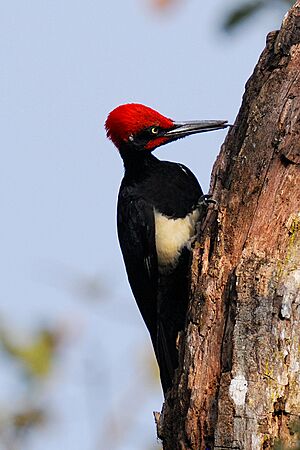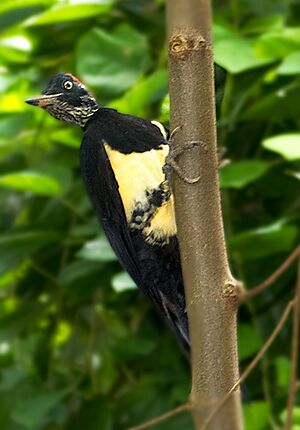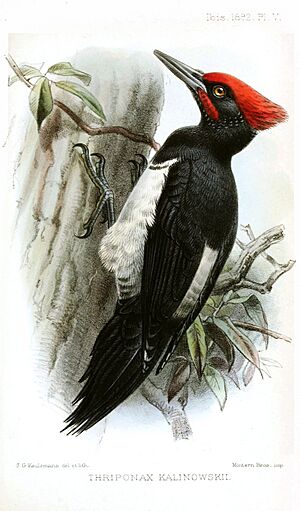White-bellied woodpecker facts for kids
Quick facts for kids White-bellied woodpecker |
|
|---|---|
 |
|
| D. j. hodgsonii | |
| Conservation status | |
| Scientific classification | |
| Genus: |
Dryocopus
|
| Species: |
javensis
|
| Subspecies | |
|
See text |
|
The white-bellied woodpecker (also known as the great black woodpecker) is a large type of woodpecker. Its scientific name is Dryocopus javensis. These birds live in warm, green forests across the Indian subcontinent and Southeast Asia. They are one of the biggest woodpeckers in Asia. They like to build their nests in large dead trees, often near rivers. There are 14 different kinds (called subspecies) of white-bellied woodpeckers. Sadly, many of the ones living on islands are in danger, and some have even disappeared completely. These woodpeckers have very loud calls and drumming sounds, much louder than smaller woodpeckers.
What Does the White-bellied Woodpecker Look Like?
This woodpecker is one of the biggest living woodpecker species. Adult white-bellied woodpeckers are usually about 40 to 48 centimeters (16 to 19 inches) long. Only the great slaty woodpecker and the black woodpecker are bigger among Asian woodpeckers. The white-bellied woodpecker is similar in size to the black woodpecker from the north and the pileated woodpecker from North America. These birds can weigh between 197 and 350 grams (7 to 12 ounces).
One type, called hodgsonii, has white feathers under its wings and a white area near its tail. Young birds of the main type might have white stripes on their throats. Scientists think that the hodgsonii type might be different enough to be its own species because of its sounds and looks. These birds can spend a long time, sometimes an hour, looking for food on just one tree.
The hodgsonii type in India lays eggs from January to May. They often use the same large dead tree for their nest year after year. Usually, they lay two eggs at a time. They mostly eat insects like ants or grubs, which they find under tree bark. Sometimes, they also eat fruit. Even though they can be shy, they sometimes build nests close to paths or places where people are active. They make different sounds, from a short, sharp kuk to longer calls like kyuk, kew, or kee-yow. The longer calls are often made before they fly away. At night, they sleep inside holes in trees.
Different Types of White-bellied Woodpeckers
There are fourteen known types, or subspecies, of the white-bellied woodpecker. Each one might look a little different or live in a different area. Here are some of them:
- D. j. javensis (found from southern Thailand to Borneo)
- D. j. philippinensis (from the Philippines)
- D. j. cebuensis (from Cebu Island); this one hasn't been seen since the 1950s and is probably gone forever.
- D. j. confusus (from Luzon)
- D. j. feddeni (from Thailand, Laos, and Burma)
- D. j. forresti (from northern Myanmar and Sichuan, China)
- D. j. hargitti (from Palawan)
- D. j. hodgsonii (mainly from the Western Ghats in India, and also central and eastern India)
- D. j. mindorensis (from Mindoro)
- D. j. multilunatus (from Basilan, Dinagat, Mindanao)
- D. j. parvus (from Simeulue Island)
- D. j. pectoralis (from Samar, Bohol, and other islands)
- D. j. richardsi (Tristram's woodpecker; found only in North Korea, but no longer in South Korea or Japan)
- D. j. suluensis (from Sulu)
The Andaman woodpecker was once thought to be a type of white-bellied woodpecker, but now it's considered its own species.
How Do White-bellied Woodpeckers Live?
These big black woodpeckers are usually seen alone or in pairs. Sometimes, a third bird might join them. When they fly, they often make a loud, single note that sounds like a laugh, chiank. They also make loud drumming sounds, especially when it's time to find a mate and build a nest.
The breeding season for these birds is mostly from January to March. They build their nests inside a large dead tree, often in open forest areas. They usually lay two white eggs. In some parts of central India, these birds have become rare.




